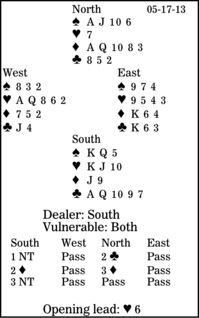Bridge column, May 17: First stayman, then three minor

As is so often true in bridge, the answer depends on something else in your methods. In this case, do you transfer into the minors?
If you do not, tune in tomorrow. If you do transfer into the minors, though, this sequence shows a four-card major, five-plus in the bid minor, and either fear for three no-trump or thoughts of a slam.
In this deal, if South had rebid two hearts, North would have jumped to three no-trump. But when South denied a major, it became possible that five (or six!) diamonds would make when three no-trump would fail because the defenders would take the first five tricks in hearts.
Here, though, South, because he disliked diamonds and had good holdings outside the suit, settled into three no-trump.
West leads the heart six: seven, nine, jack. How should South continue?
From both the Rule of Eleven and East's third-hand-high play, South knows that West has a slew of hearts ready to run if East gets on lead to return a heart. So, East must be kept off play. This means that taking the diamond finesse is wrong. Instead, declarer should take two club finesses through East.
After playing a spade to dummy's 10, South runs the club eight. West wins with his jack and (best) shifts to a diamond, but South puts up dummy's ace and takes a second club finesse, netting an overtrick with this distribution.
** ** **
COPYRIGHT: 2013, UNITED FEATURE SYNDICATE
DISTRIBUTED BY UNIVERSAL UCLICK FOR UFS

